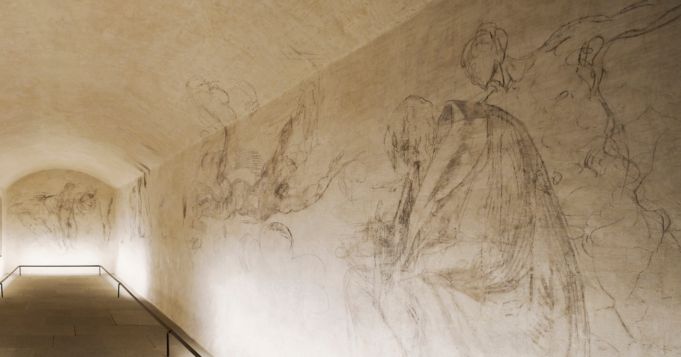Hidden chamber opens to public on 15 November
Michelangelo's little-known "Secret Room", a tiny chamber with sketch-filled walls, opens to the public almost 50 years after it was discovered hidden behind a trap door in Florence.
The precious venue at the Museum of the Medici Chapels at the Bargello Museum is accessible to the public on an experimental basis from 15 November, strictly by reservation, until 30 March 2024.
Bargello director Paola D'Agostino recently unveiled the visiting information, more than a month after the news was first announced by Massimo Osanna, director general of Italian state museums, who described the room as "a place of extraordinary charm".
Dopo quasi 50 anni dal suo ritrovamento, il 15 novembre la stanza segreta di Michelangelo, piccolo ambiente contenente una serie di disegni attribuiti al Buonarroti, all’interno del Museo delle Cappelle Medicee, sarà accessibile al pubblico.
Le infohttps://t.co/b88hL9HGqO pic.twitter.com/hHcRrrJ2ur— museitaliani (@museitaliani) November 9, 2023
Visits to the room, which can be accessed via the New Sacristy, will be limited to four people at a time, for a maximum stay of 15 minutes.
The limited access is to protect the fragile nature of the charcoal and chalk wall drawings, created by the Italian High Renaissance master in 1530.
Visiting does not come cheap however: standard tickets cost €20 in addition to a compulsory €3 reservation fee and the €10 price for the museum ticket, adding up to €33 per person.
On completion of the experimental openings in March, tests will be conducted to evaluate whether or not to keep the room open to the public.

The story behind Michelangelo's Secret Room
Michelangelo Buonarotti gifted the world a stunning artistic legacy from the Sistine Chapel frescoes to magnificent sculptures such as the Pietà, David, Moses and Laocoön.
However most people have never heard of the artist's so-called Secret Room in Florence.
During the summer of 1530 Michelangelo went "off-radar" for about three months, with no official trace of the artist's whereabouts on record.
He was in fact holed up in a secret chamber, below the Medici Chapels in the Basilica of S. Lorenzo, in hiding from the Medici on their return from exile.
Michelangelo, then aged 55, feared reprisals after he had betrayed his patrons by siding with the revolt that had overthrown them.
However the artist did not waste his time while hiding out in the tiny windowless room, which measures just 10 metres long by three metres wide and was accessed via a trap-door.
He worked feverishly on studies for projects he was working on at the time, including a revision of David and some images from the Sistine Chapel.
He also covered the walls of his cramped hide-out with sketches in charcoal and chalk, including a possible self-portrait.
When Michelangelo eventually resurfaced, after being forgiven by the Medici, he was permitted to resume work on the family’s monuments in the same chapel below which he had spent his summer in hiding.
Until 1975 nobody knew of the existence of Michelangelo's Secret Room.
When the walls of the hidden chamber were stripped, curators made a sensational discovery: sketches made by Michelangelo more than four centuries earlier.
In the intervening decades, only art experts and the occasional lucky guest have been permitted access to the tiny cell, and until now the room has never been opened to the public.
Michelangelo died in Rome, at the grand old age of 88, in 1564. He is buried at the Basilica di S. Croce, fulfilling the master's final request to be laid to rest in his beloved Florence.
For tickets and visiting information see Musei dei Bargello website.
General Info
View on Map
Florence opens Michelangelo's Secret Room to public
Piazza di Madonna degli Aldobrandini, 6, 50123 Firenze FI, Italy

















